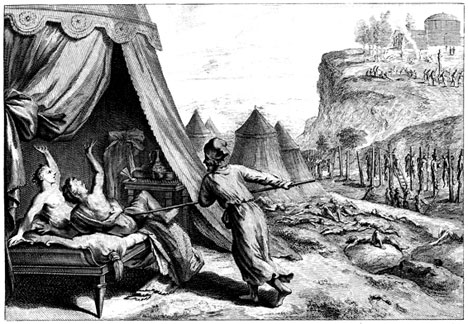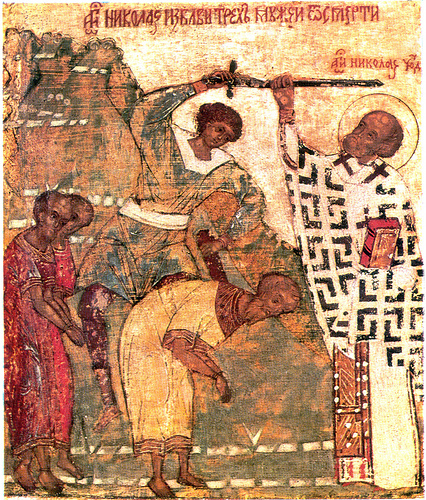Q&A: Discerning the Body
What is the referent of “body of Christ” in 1 Corinthians 11:29?
“For anyone who eats and drinks without discerning the body eats and drinks judgment on himself.”
What is the referent of “body of Christ” in 1 Corinthians 11:29?
“For anyone who eats and drinks without discerning the body eats and drinks judgment on himself.”
 or The Killer Hermeneutic
or The Killer HermeneuticAn online acquaintance asked: “There’s a hermeneutical method that’s been used on this site called ‘systematic typology’. What is it? How does one apply it? Are there contexts where it is considered to be a particularly good or particularly bad fit? Where can one go to learn more about it? And where does it come from? (Who developed it, and based on what?)
 Priests and Levites of All Nations
Priests and Levites of All NationsPart 1 | Part 2 | Part 3 | Part 4 | Part 5 | Part 6
In this final post on the structure of Ephesians, we will cover stage 6 (Conquest/Atonement) and stage 7 (Glorification/Booths). (Unfortunately, I can’t refer to them as cycles because there are 8 cycles, as previously discussed.)
A common interpretation of the “armor of God” relies on the assumption that Paul is using the kit of a Roman soldier as a metaphor. This shows how fragmented is our understanding of the Bible, an organic text which is not fragmented at all, and not reliant upon the various contemporary cultures anywhere near as much as we assume. The armor in Ephesians 6 is that of a priest, a priest with a sword, fulfilling his guard duty at the gate of God.
 Part 1 | Part 2 | Part 3 | Part 4 | Part 5
Part 1 | Part 2 | Part 3 | Part 4 | Part 5
We have reached the fifth stage of the matrix in Paul’s letter to the Ephesians, which is the sixth cycle (as discussed in part 5, stage 3 — Ascension — is often split into two parts, altar and sacrifice).
So this fifth section is the “Deuteronomy” of the epistle. It is a New Covenant version of Moses giving his final words to the children of Israel before the conquest of the Land. Likewise, Paul himself, and all the other apostles (except perhaps for John, the final word) would be gone before the rulers of the Land (Revelation’s “kings of the earth”) would be wiped off the face of it forever.
As in all previous cycles, there are some real literary wonders here, which is especially satisfying to see when the passages themselves (unparsed) are so familiar. It’s like seeing old friends in a new way: the letter resurrected and alive and walking around.
 According to a recent post by Steve Jeffery, Paul quotes seven Old Testament texts in Galatians 3:6-16. He notes that they are chiastic, but I reckon they are also Covenant-shaped:
According to a recent post by Steve Jeffery, Paul quotes seven Old Testament texts in Galatians 3:6-16. He notes that they are chiastic, but I reckon they are also Covenant-shaped:
“I will open my mouth in a parable;
I will utter dark sayings from of old… “
Psalm 78:2
The account of Samson’s marriage and the subsequent collateral damage is one of those stories out of which teachers and preachers try in vain to wring a moral. After all, isn’t that what the Old Testament is for? Actually, no. It is a history of God’s Covenants, and every single text, whether historical narrative or prophetic vision, has a Covenant structure. Certainly, there are morals, but some stories resist such an obvious use (unless we are willing to cook the Book). These stories of God’s delegated authorities are intended to illustrate the work of God in the world.
Part 1 | Part 2 | Part 3 | Part 4
It’s been a while since I blogged due to some pesky Russian hackers.
Well, it looks possible at this point that Ephesians actually has eight cycles, just as many of its “sevenfold” stanzas have eight lines. This is because step three reflects the Altar and the Table, the Land and the fruits of Day 3 (the first half of the cycle has a preliminary “filling”).
This means that the previous cycle, which spoke of the gifts to the Church, concerned the initial outpouring of the Spirit by Christ at His ascension. If that was the “three-and-a-half,” this next cycle must then be the Day 4, the governing lights, which seems to be the case as it begins with a reference to enlightenment, and proceeds to comment on what this looks like in the saints. If this is indeed the structure here, what follows below is the “Ethics opened” section of the epistle. The new Israel will not be given to harlotry in the wilderness, as the old one was.
We have arrived the central cycle, the “Pentecost” of the epistle. Here’s how it looks so far:
The first cycle of Ephesians expressed the call and adoption of God’s sons as a new Creation (Sabbath). At its very centre was the phrase, “the forgiveness of our trespasses.” At the centre of the second, which concerned the removal of the Veil of Moses, was “the sons of disobedience,” a Division between the sons of the promise and the sons of the flesh (Passover). This division was obviously no longer founded on genealogy but began with voluntary allegiance to Jesus. Circumcision or uncircumcision became irrelevant.
 Part 1 here.
Part 1 here.
Bible commentators will tell you that Paul’s epistle to the Ephesians contains great riches. Unfortunately, without any reference to its Mosaic literary structure, it comes across as a jumble of jewels in a treasure chest. However, analysis of the structure allows us to appreciate the fine networks and chains of thought in the literary architecture — and also the clever allusions contrasting old Israel with the New. It also demonstrates Jesus’ fulfillment of the Mosaic Law.